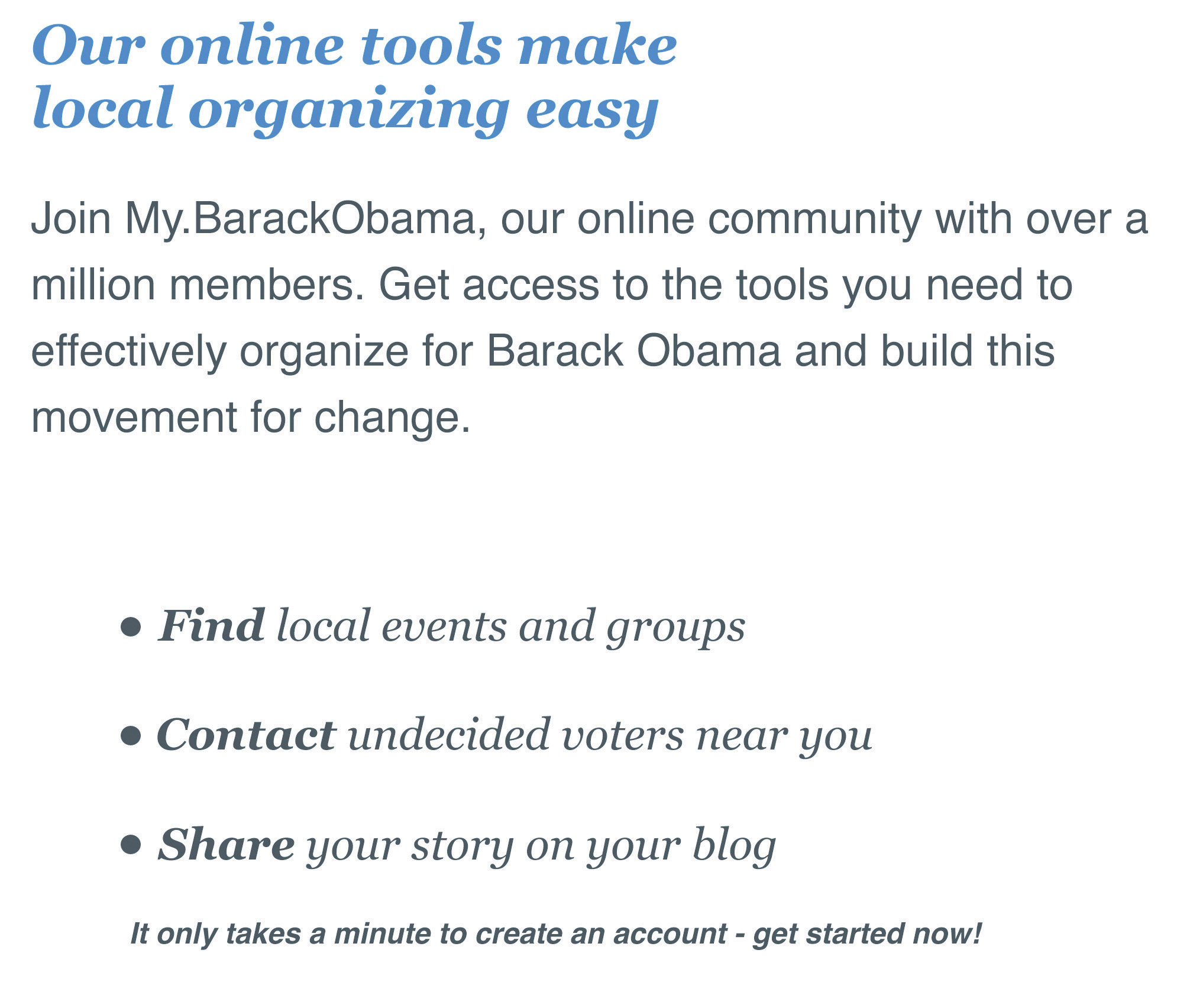The 2008 U.S. presidential election was historic for many reasons and was keenly followed worldwide. Barack Obama’s campaign made unprecedented use of grassroots channels to generate support, encourage voter turnout, and raise funds with savvy use of the Internet to support its campaign. While with hindsight it may be plain to see how much the campaign got right, when Barack Obama started campaigning for the Democratic Party’s nomination, he was seen as an outsider. For much of that campaign, the media branded Barack Obama as the underdog.
The World Wide Web appears daunting to many big businesses and organizations. In politics, especially, few have incorporated the tools of the Web into successful campaigns to date. As with business, the Web was seen as an emerging channel in politics. This meant that the candidates that Obama was running against, in both the campaign for the Democratic nomination and in the presidential campaign, were focused on traditional tactics for gathering support. Not being the front-runner, Obama needed to engage with voters in new ways in order to succeed. The use of social media made the most of the Obama campaign’s greatest strength—its grassroots, community connections.
When it comes to elections in the United States, young voters are the toughest demographic to reach. It’s a challenge shared by many businesses and organizations trying to reach out to a younger audience. They find that traditional channels, such as television advertising, are having less and less of an impact. Instead of watching television, younger people are turning to the Internet and their mobile phones for entertainment and for interacting with their friends. Savvy brands that want to reach this market are turning to the same channels.
The Obama campaign realized early on that without the traditional support enjoyed by the other candidates, it would need to find new ways to raise funds and reach voters. As the Edelman Trust Barometer consistently shows, people are more likely to trust and listen to “someone like me.”Erica Iacono, “Edelman Trust Barometer Finds ‘Person Like Me’ as Most Credible Spokesperson,” PRWeek, January 26, 2006, http://www.prweekus.com/pages/login.aspx?returl=/edelman-trust-barometer-finds-person-like-me-as-most-credible -spokesperson/article/54048/&pagetypeid=28&articleid=54048&accesslevel=2& expireddays=0&accessAndPrice=0 (accessed June 20, 2010); “Edelman Trust Barometer 2010 Executive Summary,” Edelman, 2010, http://www.scribd.com/full/26268655?access_key=key -1ovbgbpawooot3hnsz3u (accessed June 20, 2010). The best way to reach these “people like me” is to use existing social connections. The Obama campaign used this to create a social network, http://www.my.barackobama.com, that supporters could use to self-organize events, connect with other supporters, and receive feedback and support from the campaign. According to Quantcast figures, this network saw over a million visitors each month, eclipsing two million visitors in some months.“Quantcast Figures for my.barackobama.com,” Quantcast, June 2010, http://www.quantcast.com/www.my.barackobama.com (accessed June 23, 2010).
Figure 19.7 Image from My.BarackObama

For best results in making use of social connections, existing social networks should also be utilized. Even though the previously mentioned social network my.barackobama.com was the hub of the campaign, profiles were created on all major social-networking Web sites to enable the campaign to reach out to supporters in as many channels as possible. Profiles, groups, and pages were created on Facebook, Twitter, and YouTube to name just a few. In fact, photographs from election night were released by the Obama campaign on Flickr. Top-viewed videos on the campaign’s official YouTube channel have received over five million views each.
The campaign also made excellent use of a number of other eMarketing tactics, all carefully co-coordinated to make supporters feel as engaged and involved in the campaign as possible. While Hillary Rodham Clinton raised $13.5 million in January 2008 to support her campaign, mostly through large, traditional fund-raising events, Barack Obama raised $36 million in the same month. Of that, $28 million was raised online with 90 percent of those transactions coming from people who donated $100 or less, and 40 percent from donors who gave $25 or less. Even small donors felt that they, personally, were making a difference.
The Obama campaign used every opportunity for interaction to collect information that would allow it to connect further with potential supporters, from e-mail addresses to mobile phone numbers and zip codes for precise e-mail marketing. In fact, in what was probably the largest mass short message service (SMS) communication to date, the Obama campaign announced Joe Biden as Obama’s running mate via SMS to an estimated 2.9 million supporters.
Search is playing an increasingly important role in current affairs, and with that comes online reputation management. All candidates realized this, and made good use of search marketing to complement their other media campaigns.
Figure 19.8 A PPC Advertisment for the Obama Campaign

For example, when the McCain campaign was talking about Obama’s association with Bill Ayers, a leader in U.S. education reform, many people turned to their favorite search engine to find out more. The Obama campaign ran a PPC (pay-per-click) campaign, buying contentious search terms and advertising a Web site that portrayed its side of the story: http://www.fightthesmears.com. Timely PPC and a well-run Web site helped it to manage its reputation online.
The swelling grassroots support was channeled and supported by the Obama campaign, leading to an unprecedented number of volunteers and donations that helped the campaign to victory in the U.S. presidential elections. However, like any organization that has found success in reaching out to its constituents in remarkably new ways, that success carries with it a lot of expectation. After feeling so heavily involved in the electoral campaign, many supporters are now expecting to be as involved in the new presidency. Barack Obama has continued to use social media channels to reach out. He now conducts a weekly address, not on television, but on YouTube. Americans are invited to follow his transition team, and offer their thoughts and suggestions, on the Web site http://www.whitehouse.gov.
The Obama campaign’s strategic use of the Internet, and particularly online tools for connecting with supporters, has changed worldwide expectations of politics and the Internet. Savvy use of social networks and tools that encouraged and enabled mass participation may have made all the difference to this campaign.